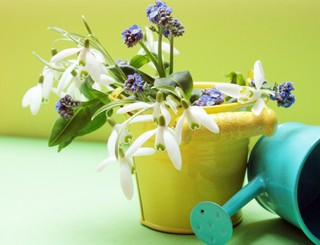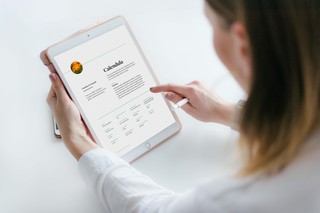7 ways to water indoor plants while on vacation

Sometimes getting away from it all is just what you need to hit the reset button, but what happens to all the houseplants you leave behind? If you’ve ever returned home from a relaxing trip only to find your beloved houseplants drooping, desperate, and dying, then you know exactly how seriously sad a way to end a vacation this is.
But it doesn’t have to be this way. Even if you don’t have a dependable friend or neighbor to take care of watering while you’re away, there are a number of ways to make sure that your leafy companions are thriving when you get back home.
Considerations
Plant Types & Needs
The types of indoor plants you keep will make a significant difference in the water level they need to stay healthy in your absence. Succulents and cacti don’t require any special care and prefer to be left alone. Your indoor vegetable garden and herbs, on the other hand, are going to need more attention than most. Don’t attempt any self-watering system with orchids, as their roots need to dry out between waterings–you’re better off leaving these plants with a friend while you’re gone.
Short Trips
First of all, timing is everything, so bear in mind that if you’re leaving for less than a week there is nothing to worry about. As long as you give all your plants a nice, long drink before leaving, they should be just fine until you return. Don’t go overboard, though– too much water (1) can have as negative impact on potted plants as not enough water.
 Not all plants require the same amount of water. Succulents don’t need nearly as much watering on a regular basis compared to herbs for instance.
Not all plants require the same amount of water. Succulents don’t need nearly as much watering on a regular basis compared to herbs for instance.
Plant Location
Any potted plants sitting in sunny, south-facing windows might need to take a step back to a shadier spot if it is summertime, because water evaporates more quickly in the warm temperatures and direct sunlight. Worst-case scenario, consider moving these plants to a garage or basement if you fear it may be too hot and sunny for them to stay hydrated inside.
Pot material and pot type
The material, size, and style of a pot will have a significant impact on the watering needs of the plant inside it. Plants in self-watering planters will need much less frequent watering than plants in normal pots with drainage trays. Terra cotta pots allow soil moisture to evaporate more quickly than glazed ceramic or plastic pots. Almost as important as pot material is pot size. Any pot under six inches in diameter will dry out quite quickly, whereas a pot ten inches in diameter or greater will retain moisture for a much longer stretch of time. Small plants will also suffer more than large plants from less water being available
Prepare for takeoff
One of the most useful actions you can take to prepare your plants for their time without you is to make an accurate assessment of each of your plant’s water needs. For a few weeks before you leave, water each of your plants with a large measuring cup or marked jug (a blender body is a good option) and make a note of how much water is required of each plant and how often. Knowing exactly how much water your plants need can help you instruct a plant sitter or set up the perfect DIY self-watering system.
Methods
Watering methods break down into two main categories, DIY watering solutions and commercially available irrigation systems. First we’ll cover DIY solutions then go into some more of the professional solutions. Both ways work well if used properly, it’s more a matter of finding the right solution for your budget, time and effort. Also, how much you have investing in your indoor garden. Some solutions will give more piece of mind than others while you’re away and that can be worth a lot to a worried traveler. Let’s jump in.
DIY watering solutions
1. Wicking System
This is one of the simplest mechanisms to use to make a self-watering system. You need a container that can hold enough water for your plant or plants and some sort of wicking material that is long enough to reach from the bottom of the water vessel to a couple of inches beneath the surface your plant’s potting soil.
Appropriate wicking materials include cotton or nylon rope, twine, clothesline, yarn, or even a cut garment like a T-shirt or jeans. The important part is the length. Cut the length of your wicks to the ideal length for each pot, and then gently push one end into the soil of the plant to be watered and the other end into the water container so that it touches the bottom.
That’s all! The water will move from the source to the plant at a slow, consistent rate that ensures the potting soil remains moist while you are away.
2. Drip System
Another super-easy watering system is a drip system made by repurposing plastic water bottles. To use a plastic water bottle, simply make a few holes in the cap using a drill or a hammer and nail. Fill the bottle with the amount of water your plant needs (based on your assessment) and then turn the bottle upside down, burying the cap in the potting soil, taking care not to damage the roots. As the soil dries, water will now slowly release into the soil. To do this with a wine bottle, turn the water-filled bottle upside down while blocking the opening with your thumb and bury it in the soil. If you’re worried about this releasing too much water at a time, read a little further on about ceramic spikes that can be purchased and used with wine bottles.
3. Plastic bag greenhouse
For plants in small pots or for long stretched away, this is a perfect solution for hassle-free plant care while away. Using the largest clear plastic bag you can get your hands on, place a towel inside to protect the bottom, and then rest your plants on top of it. Gather the top of the bag and use either a vacuum in reverse or blow manually into the bag to inflate it–you don’t want the leaves to touch the plastic. Seal the bag tightly using a zip tie.
What you are essentially creating here is a greenhouse, which is less of a watering system and more of a water-recycling system. Of critical importance is that this bag is nowhere near direct sunlight. If it is, then you’ve made a solar cooker that will completely destroy your green buddies.
4. The long bath
Requiring no special equipment or assembly, the long bath is the most low-tech solution to the problem of plant watering while you’re away. Just lay an old towel in the tub to protect the surface, then place the pots on top of it. Now, fill the tub with a few inches of water and you’re ready to go. Note: this is only effective if the pots used have drainage holes and there is sufficient natural light in the bathroom to satisfy your plants’ needs.

Commercially available irrigation systems
5. Soil-Based Solutions
For people who know they will be traveling on a regular basis, adding Terra-Sorb to their potting soil is an easy way to help extend the length of time soil stays moist. The crystals absorb 200 times their weight in water and slowly release it to the soil as it dries out. Alternately, adding a layer of mulch to the surface of the soil in a pot will slow down evaporation and can help the soil retain precious moisture. Either of these solutions is enough to help house plants survive trips of a week or less.
6. Self-Watering Pots
These are planters designed to consistently deliver water to plants via the pot they are in, and they work very well. There are also kits available for converting normal pots to self-watering, which can help keep your plants happy during vacations.
7. Watering Spikes/Globes
These nifty little devices, ceramic watering spikes, are designed to be used with empty wine bottles, and they are extremely effective at distributing moisture slowly, on an as-needed basis. The only thing to be cautious of is the glass bottle cracking the brittle terra cotta. The terra cotta is porous and will only release water to the soil as it dries out, maintaining even water levels in the soil. Similar to watering spikes, watering globes operate using the same principles but are quite beautiful and many people choose to use them in both indoor and outdoor plants to help with watering.
While outdoor potted plants can be connected to a timed, pressurized drip system (2) or a sprinkler, neither of these is appropriate for indoor plants due to their potential for leaking and damaging parts of your house.
Just because you go on vacation doesn’t mean your plants have to suffer. Whether you are handy and love DIY projects, or want a lasting commercial solution, there is something that will work for you.

The enthusiast's guide to herbs
We’re proud to present our new e-book, The Enthusiast’s Guide to Herbs! Learn everything you need to know about growing and caring for herbs indoors, including in-depth info cards for the 35 most commonly grown herbs.
Click the link below to find out more!

